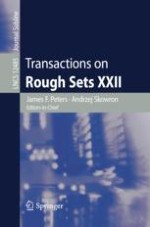2020 | OriginalPaper | Buchkapitel
Sequences of Refinements of Rough Sets: Logical and Algebraic Aspects
verfasst von : Stefania Boffa, Brunella Gerla
Erschienen in: Transactions on Rough Sets XXII
Verlag: Springer Berlin Heidelberg
Aktivieren Sie unsere intelligente Suche, um passende Fachinhalte oder Patente zu finden.
Wählen Sie Textabschnitte aus um mit Künstlicher Intelligenz passenden Patente zu finden. powered by
Markieren Sie Textabschnitte, um KI-gestützt weitere passende Inhalte zu finden. powered by
Abstract
In this thesis, a generalization of the classical Rough set theory [83] is developed considering the so-called sequences of orthopairs that we define in [20] as special sequences of rough sets.
Mainly, our aim is to introduce some operations between sequences of orthopairs, and to discover how to generate them starting from the operations concerning standard rough sets (defined in [32]). Also, we prove several representation theorems representing the class of finite centered Kleene algebras with the interpolation property [31], and some classes of finite residuated lattices (more precisely, we consider Nelson algebras [87], Nelson lattices [23], IUML-algebras [73] and Kleene lattice with implication [27]) as sequences of orthopairs.
Moreover, as an application, we show that a sequence of orthopairs can be used to represent an examiner’s opinion on a number of candidates applying for a job, and we show that opinions of two or more examiners can be combined using operations between sequences of orthopairs in order to get a final decision on each candidate.
Finally, we provide the original modal logic \(SO_n\) with semantics based on sequences of orthopairs, and we employ it to describe the knowledge of an agent that increases over time, as new information is provided. Modal logic \(SO_n\) is characterized by the sequences \((\square _1, \ldots , \square _n)\) and \((\bigcirc _1, \ldots , \bigcirc _n)\) of n modal operators corresponding to a sequence \((t_1, \ldots , t_n)\) of consecutive times. Furthermore, the operator \(\square _i\) of \((\square _1, \ldots , \square _n)\) represents the knowledge of an agent at time \(t_i\), and it coincides with the necessity modal operator of S5 logic [29]. On the other hand, the main innovative aspect of modal logic \(SO_n\) is the presence of the sequence \((\bigcirc _1, \ldots , \bigcirc _n)\), since \(\bigcirc _i\) establishes whether an agent is interested in knowing a given fact at time \(t_i\).
